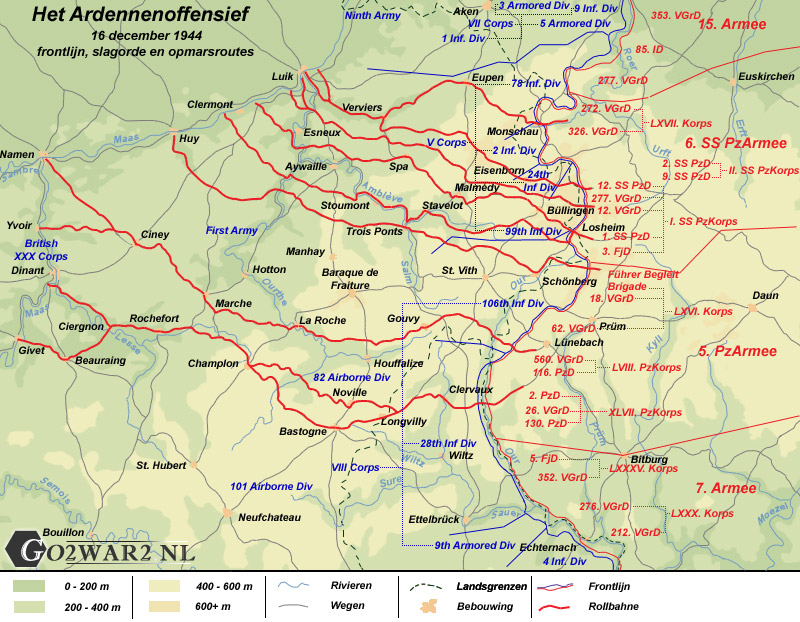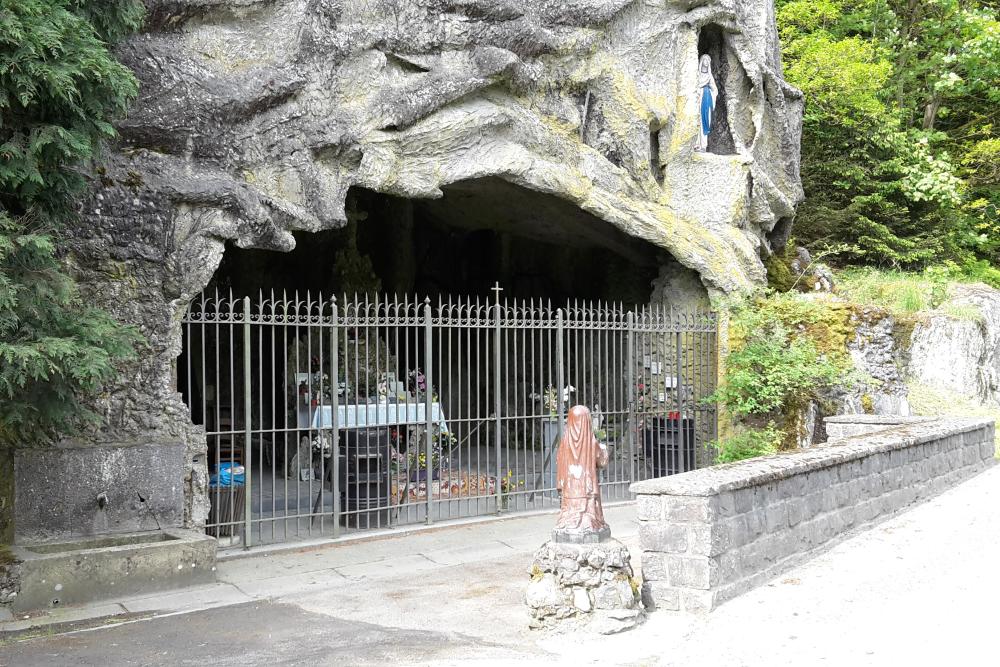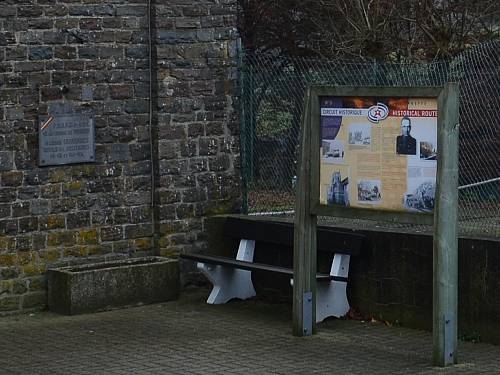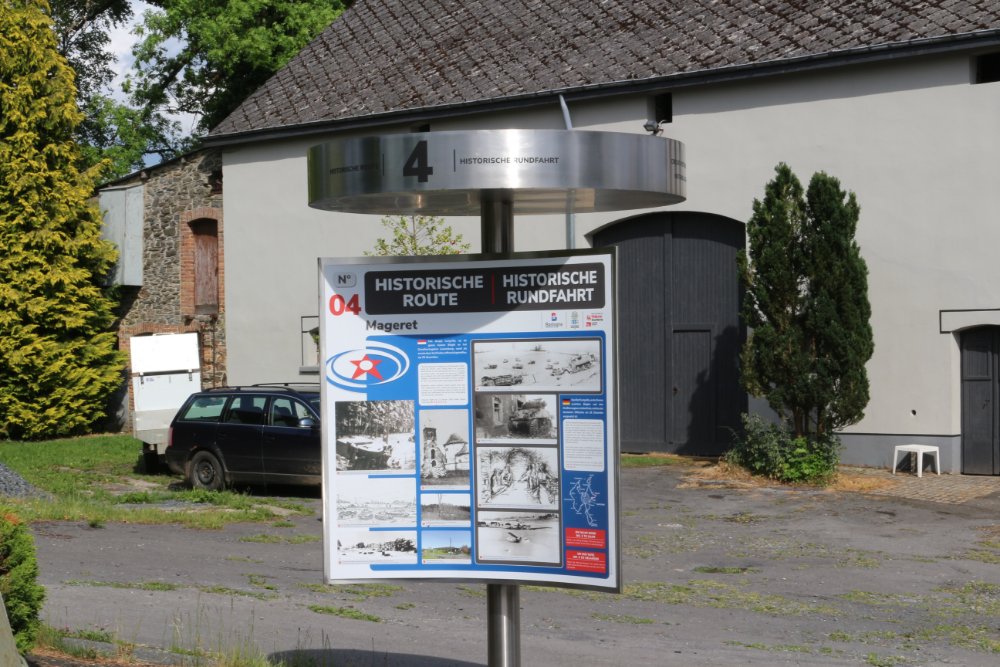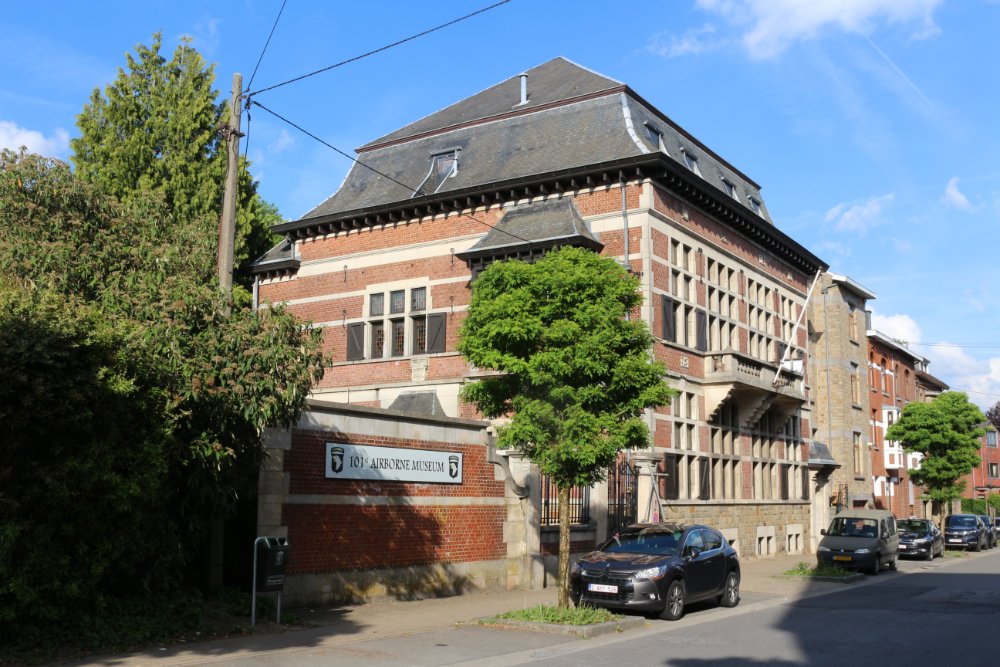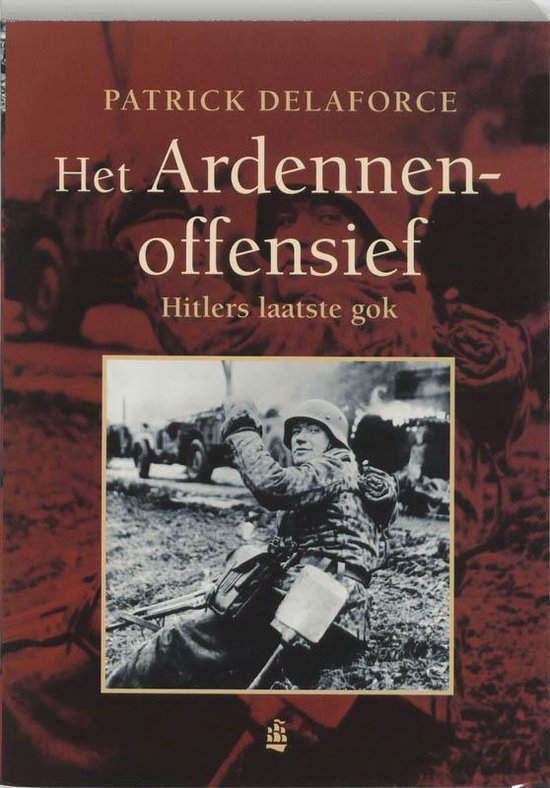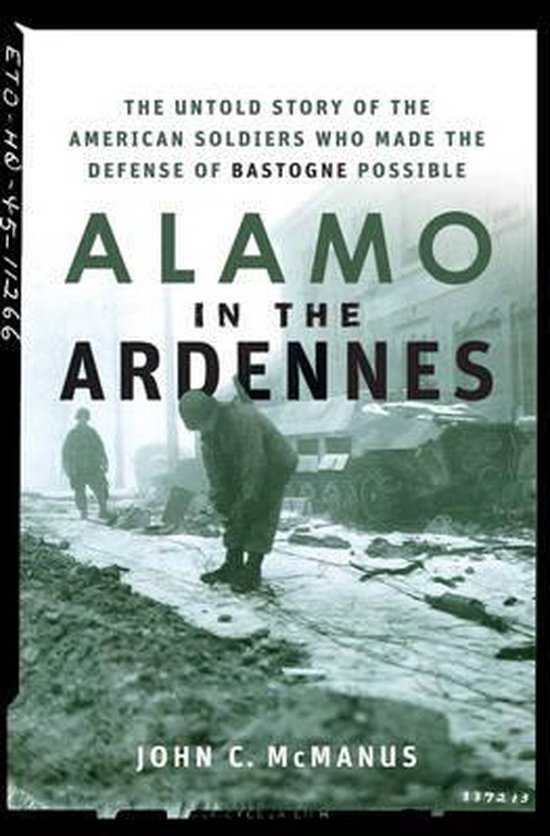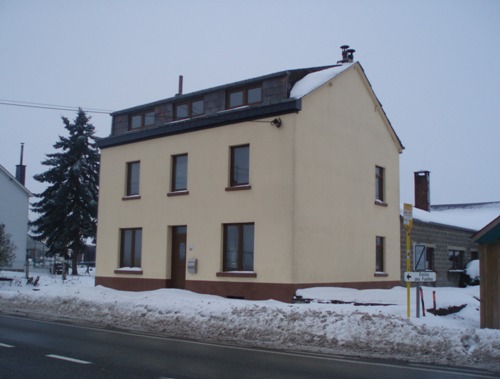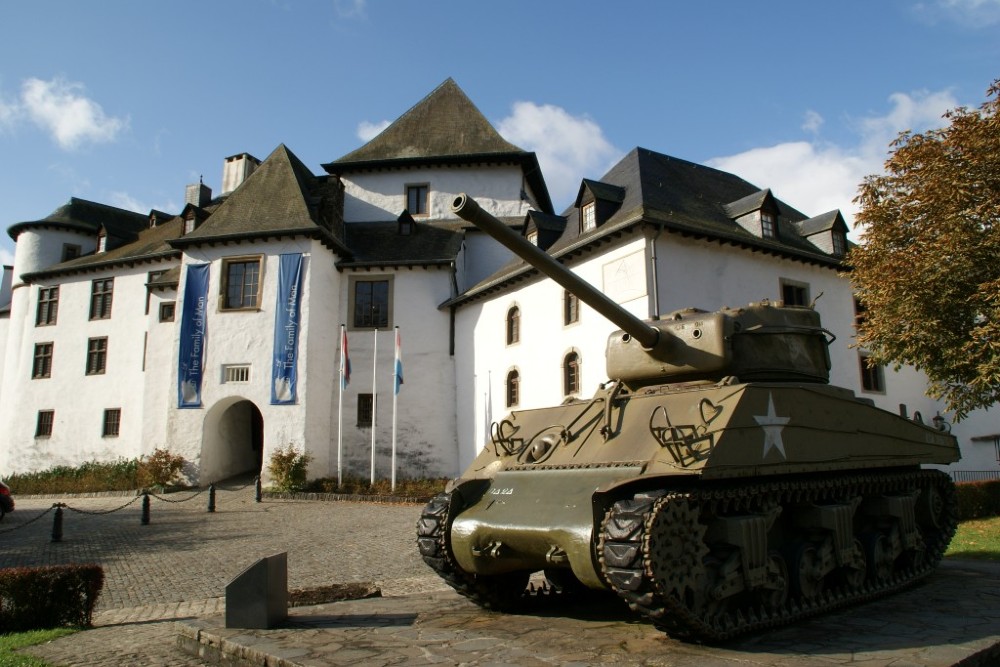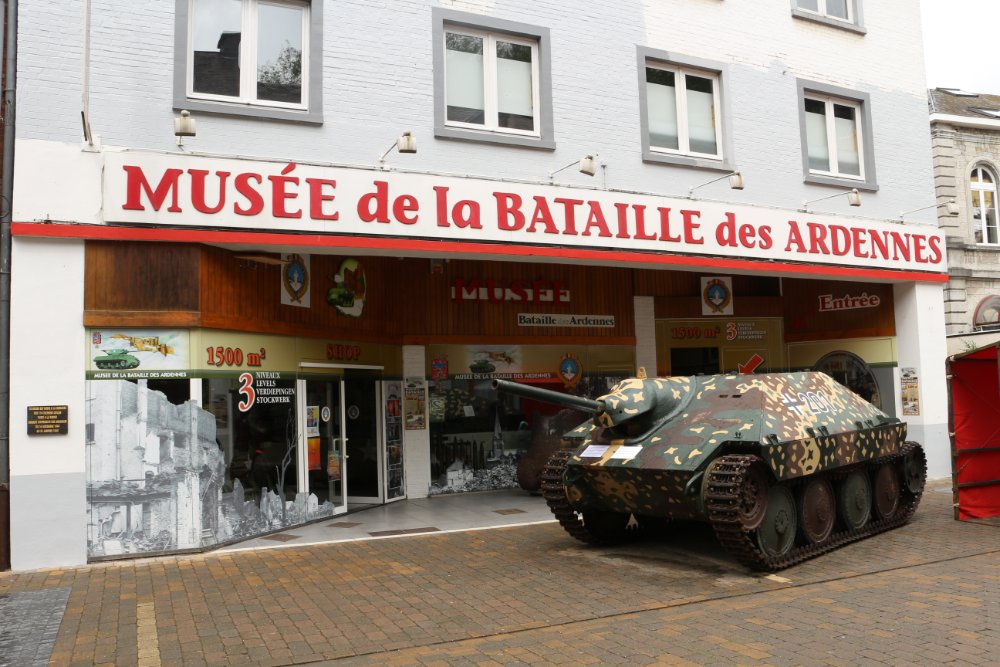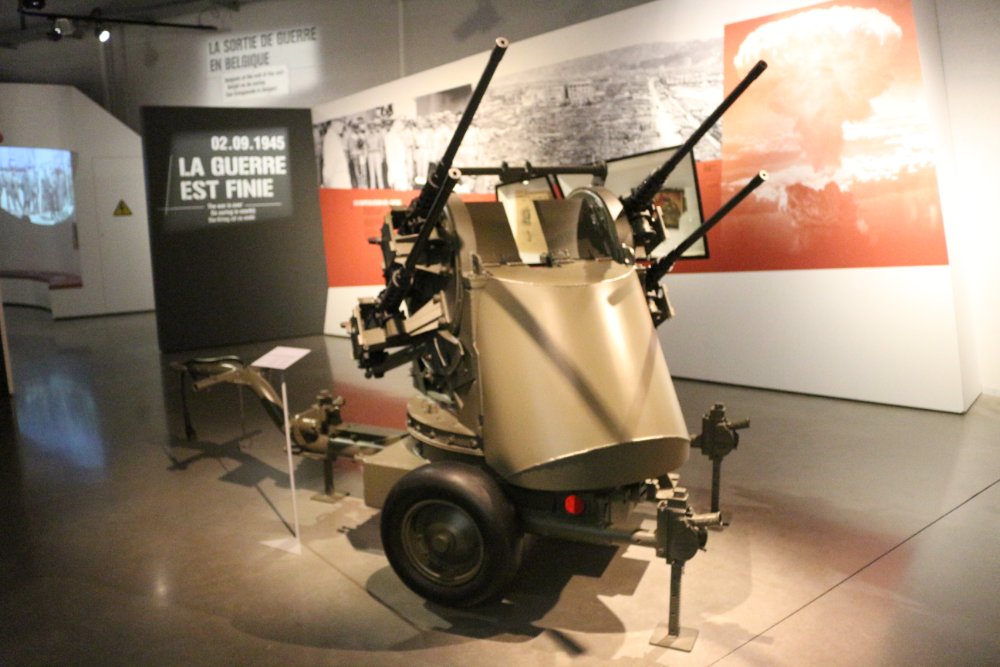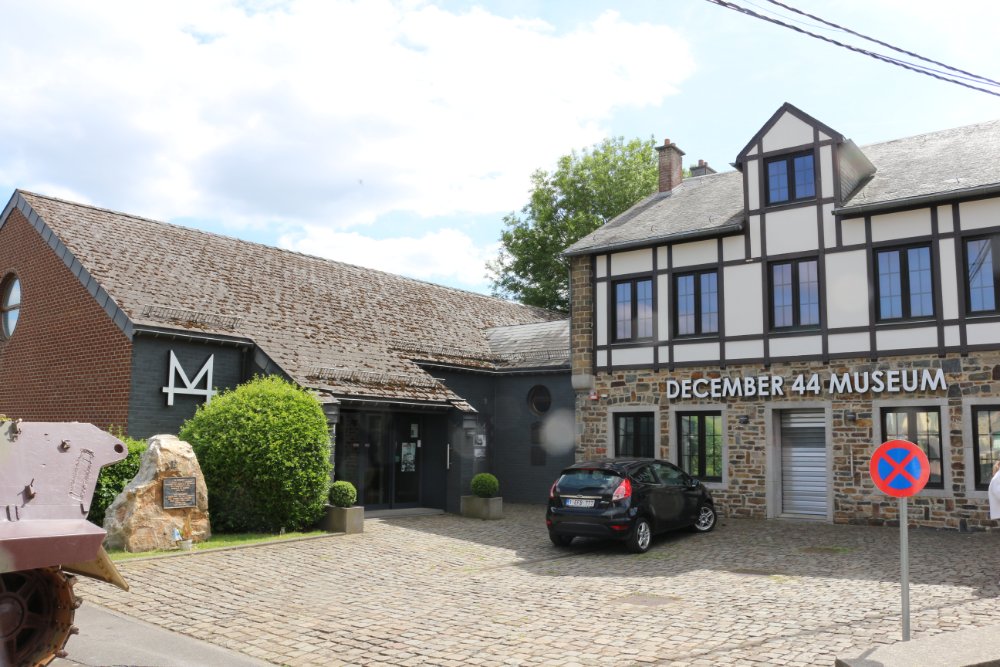Introduction
The battle for Bastogne was a decisive moment during the Ardennes offensive. The harsh wintery conditions and the fact that the paratroopers of the 101st Airborne Division were poorly rested and completely surrounded, made the successful defending of the city into a heroic happening. Also thanks to this martial exploit the 101st has become immensely popular. Many books, articles and movies have been dedicated to it. But much less well-known are the efforts and stories of the men of the 28th Infantry Division and units of the 9th and 10th Armored Divisions. Without their heroic performance the Germans would have reached the town already before the 101st Airborne Division. They succeeded, although being a vast minority, in delaying the German advances in the direction of Bastogne in such a way that the paras of the 101st could dig in around and inside the town.
Definitielijst
- Ardennes offensive
- Battle of the Bulge, “Von Rundstedt offensive“ or “die Wacht am Rhein“. Final large German offensive in the west from December 1944 through January 1945.
- Infantry
- Foot soldiers of a given army.
- offensive
- Attack on a smaller or larger scale.
- paratroopers
- Airborne Division. Military specialized in parachute landings.
Images
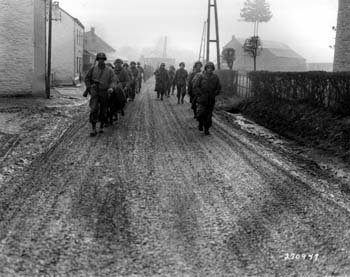 Soldiers of the 28th Infantry Divioson in Bastogne. Source: U.S. Army Center for Military History.
Soldiers of the 28th Infantry Divioson in Bastogne. Source: U.S. Army Center for Military History.Vulnerable rest-center
The Ardennes were considered by the Supreme Command as being a quiet sector at the front. A Ghost Sector where war was at leisure. The 28th Infantry Division was sent over here in order to recover from the heavy fighting in the Hürtgenwald [Hurtgen Forest]. In only two weeks’ time 6.000 men of the division had been killed, wounded or had been missed in action there. Battalions (900 men) had become the size of companies (190 men), companies the size of platoons (40 men) and platoons the size of sections (12 men). Many veterans had been continuously in action already since the invasion in Normandy and badly needed time to recover. Slowly replacements for the 6.000 men trickled in; many of them rookies without any battle experience. Veterans went on leave in cities like Paris.
Most `troops in the Ardennes had a roof over their head, contrary to the months before and felt relatively safe. They were engaged in training, manned outposts and relaxed. It looked like the Germans did the same. Thanksgiving Day was celebrated with the most delicious food, at least in their soldier’s opinion. Expecting Christmas the troops dreamed about turkey.
The consequence of the fact that the Ardennes were considered to be a quiet sector was a long, thinly stretched front. The line was occupied by soldiers of the American VIII Corps of Lieutenant General Troy Middleton. The length of the frontline was 120 kilometers, three times as much as usual. Apart from that, they were not the strongest and most experienced units of the allied forces of that moment. The 28th Infantry Division was flanked by the 106th and 4th Infantry Divisions and by the 9th Armored Division.
The 106th Infantry Division was the newest division in Europe and had landed on the continent only a few days before. Also the 9th Armored Division had no battle experience. Apart from that, this division had only one of its three battle groups available, the Combat Command Reserve. The 4th Infantry Division , like the 28th Infantry, had been fighting in the Hürtgenwald till halfway November and had lost 3.500 men.
Definitielijst
- Infantry
- Foot soldiers of a given army.
- invasion
- Armed incursion.
Images
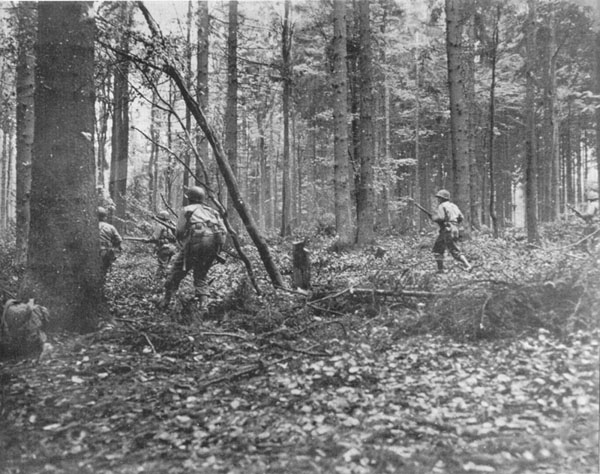 Troops of the 28th Infantry Division in the Hürtgenwald. Source: U.S. Army Center for military History.
Troops of the 28th Infantry Division in the Hürtgenwald. Source: U.S. Army Center for military History.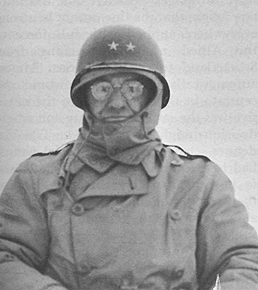 General Troy Middleton Source: U.S. Army Center for military History.
General Troy Middleton Source: U.S. Army Center for military History.The surprising German plan.
In the 28th Infantry-sector various indications demonstrated a nearing attack. Yet it was a big surprise for the Americans when they were attacked on December the 16th, 1944.This was the consequence of badly analyzed intelligence, non-forecasting commanders and bad weather. The intelligence officers of the division had received warnings from several civilians. They had remarked the supply of fresh German troops and transport equipment. A young German soldier even had told Marguerite Lindenmeyer, a Luxembourgish girl, that the German Army would be in Paris again at Christmas. Some American intelligence officers did dedicate value to the stories and started to act on them. For example the 110th Infantry Regiment had prepared a plan in case the Germans would attack. Most American intelligence officers however didn’t consider the matter as being serious and did not believe in the possibility of an offensive. In their mind, the backbone of Hitler’s forces had been broken. The allied intelligence estimated that the Germans were only able to take defensive actions. So did General Bradley, one of the most important allied generals. During a visit to the Ardennes, Middleton pointed out the thinly occupied frontline and asked Bradley to send extra reinforcements. Bradley laconically answered: "Don’t worry Troy, they won’t come through here."
And then there was the bad weather. Aerial pictures were the most important sources of information about the enemy during the war. As a consequence of rain, fog and sleet the allied reconnoiter planes in the Ardennes were grounded in the weeks leading up to the 16th December. That’s why the Germans had been able to gather an enormous battle force unnoticed.
In 1940 the Germans had surprised friend and foe with their lightning strike attack through the Ardennes. Everybody had considered this to be impossible. The landscape of the Ardennes is extremely difficult to cross by tanks and armored vehicles. That is why also in the winter of 1944 nobody counted with a German attack in exactly that same area. Hitler wanted to break through the American lines (four divisions strong) with two armored armies (together 16 divisions). The German tanks would have to reach the river Meuse and in doing so separate the British troops from the Americans. In that way the Germans aimed to force a breach between the two most important allied powers.
General Hasso von Manteuffel was the commander of the 5. Panzerarmee [5th Armored Army]. Bastogne was on his way to the Meuse. This city was an important crossroads for traffic in the Ardennes and of great strategic importance to the Germans. Whoever controlled this town, would be able to quickly move his troops and transports and to manage the situation in the Ardennes. Von Manteuffel wanted Bastogne conquered in the afternoon of the 17th of December. The 28th Infantry Division was the only allied unit that could block his entering the city.
Definitielijst
- Infantry
- Foot soldiers of a given army.
- offensive
- Attack on a smaller or larger scale.
- Regiment
- Part of a division. A division divided into a number of regiments. In the army traditionally the name of the major organised unit of one type of weapon.
Images
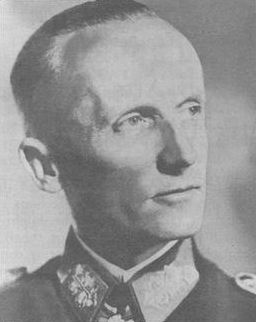 General Von Manteuffel. Source: U.S. Army Center for military History.
General Von Manteuffel. Source: U.S. Army Center for military History.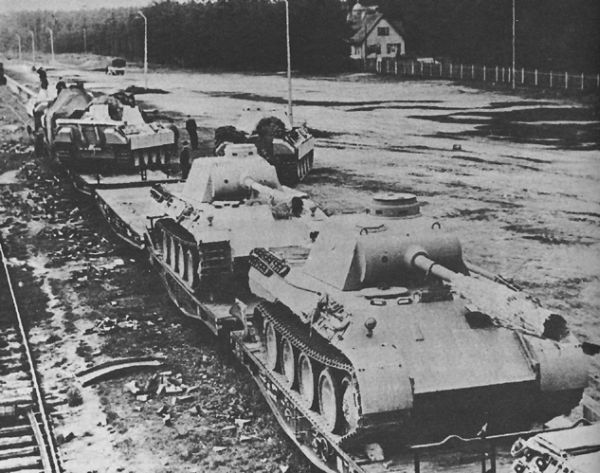 German tanks are assembling at the Ardennes front Source: U.S. Army Center for Military History.
German tanks are assembling at the Ardennes front Source: U.S. Army Center for Military History.The attack and the American counteract.
After sunset on December 15 the German artillery observers succeeded in infiltrating the American lines. They hid in small villages and thus were able to communicate the exact positions of the Americans to their artillery. In the early hours of 16 December all hell broke loose in the Ardennes. Many Americans were sleeping and jumped out of their beds head over heels in order to seek cover in the cellars. The soldiers on watch in the advanced positions jumped into their foxholes. Everybody was scared to death. While the grenades exploded all around them. The air was filled with mortal shrapnel and flying debris. "The booming explosions rocked the earth and showered us with dirt. The concussions gave us a head ache. We crouched down in our fox holes and pray for the pounding to cease." said Private Jackson of the 28th Infantry Division.
In spite of the destructive forces of the artillery barrage the American losses were limited. But a lot of damage was done to houses, the infrastructure and many communication lines were broken. The population was worried about what was going to happen. They feared that their liberated villages again would become occupied by the Germans. Following the artillery shelling the German infantry attacked. The soldiers of the 28th Infantry Division, indeed shocked by the bombardment, but not annihilated, offered strong resistance, which caused the enemy commandos to break through the lines a lot less quick than expected.
In order to keep up the speed of their advance the Germans omitted to exterminate several American centers of resistance. The infantry of the next wave of attack had to eliminate these small groups of soldiers. In some cases these groups counted only four or five men. They refused to surrender and succeeded in delaying the German attacking units (some at least ten times their strength) for a longer period of time. In the beginning of the attack the German infantry suffered heavy losses as a result of the tough resistance of the 28th Infantry Division.
The German superior power was devastating. The three regiments of the 28th ID each faced a complete German division. There was little the commander of the 28th , Major-General Norman Cota , could do in this situation. He had hardly any or no contact with his regiments and he also had only few reserves he could deploy in order to halt the German advance. Normally spoken a regiment was held in reserve for each division, but in order to reinforce the far stretched frontline Cota had already posted all his regiments in the first lines. The only reserve with some power Cota had available was the 707th Tank Battalion equipped with Sherman and M5 Stuart tanks. He was careful in engaging the tanks as he did not want to waste his reserves immediately.
In the meantime everything was being done to stop the German attackers. Even provisional troops were assembled consisting of men from the military police, cooks and administrative personnel. Here and there small groups of Americans were forced to surrender as they ran out of ammunition or because the superiority had become so strong that continuing to fight was useless. Small units withdrew from their villages in order to build up new barricades in the following village. It cost a lot of time to the Germans to destroy these barricades and time was of the essence in their strict schedule. General Cota ordered his division to hold out at all cost. He realized that his division was the only unit of some importance between the Germans and Bastogne. If Cota and the allies wanted to create the possibility to defend the town, the 28th had to sacrifice itself in order to gain time.
It was the only option to provide the 101st Airborne Division with the much needed time to reach the city and to prepare for its defenses. The paratroopers were indeed almost immediately sent to the Ardennes when General Dwight Eisenhower was informed about the German break through. A tragic example of the sacrificing of the 28th Infantry may appear from the statement of Charles Johnson, an artillery observer: "Another observer was still somewhere in Manarch, radioing fire missions to the battery. The Germans were so close to him that he was trying to call down fire on his own building. In his last transmission he whispered: Hurry, fire, they are coming up the steps."
Definitielijst
- Infantry
- Foot soldiers of a given army.
- paratroopers
- Airborne Division. Military specialized in parachute landings.
- regiment
- Part of a division. A division divided into a number of regiments. In the army traditionally the name of the major organised unit of one type of weapon.
- resistance
- Resistance against the enemy. Often also with armed resources.
- shelling
- Indication for shooting targets with grenades. Both from artillery and armoured artillery.
Images
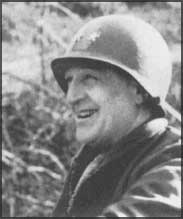 General Cota, commander of the 28th Infantry Division Source: U.S. Army Center for military History.
General Cota, commander of the 28th Infantry Division Source: U.S. Army Center for military History.Continuous fighting
In the late afternoon of 16 December the German sappers had succeeded in constructing two pontoon bridges across the river Our in the sector of the 110th Infantry Regiment. Finally Von Manteuffel was able to deploy the armored troops into the battle. The Americans now had to also face the tanks of the 2. Panzerdivision and the Panzer Lehr Division. Small groups of German tanks could be eliminated in some cases, but when the Germans brought all the time more tanks into the battle, many Americans had to recognize the superior power of their German opponents. In the north, the soldiers of the 28th Infantry Division received support from their inexperienced comrades of the 106th Infantry Division. In the sector of the 112th Infantry Regiment the Americans succeeded in holding on to the bridges across the river Our.
More and more Americans ran out of ammunition. This forced them to surrender to the Germans. Here and there small groups succeeded in slipping through the German lines. These groups consecutively were reassembled into provisional units and put back to fighting again. Those who did not reach their own lines, went into a long and gruesome period as prisoner of war. For many this was going to be a time of hunger and misery.
The inhabitants of the villages that were assaulted by the Germans or which they thought that would become part of the frontline, were recommended to flee. Many civilians did not. Some had created bonds with the Americans and chose to endure every hardship. Many saw their village being destroyed and lived through hazardous days in cellars and shelters.
The 17th of December started with a new artillery barrage. Again this did not make many victims, but caused mainly material damage. The 112th Infantry Regiment had made a plan for a counter attack. Therefore also tanks of the 707th Tank Battalion were used., the only reserve. This however appeared to be too little to stop the Germans. The light Stuart tanks were no match for the Germans. They were being deployed in small groups, which took away the force from the attack.
Also after two full days of heavy fighting the Germans had not yet succeeded in the sector of the 112th Infantry Regiment to reach the Our. Crossing this river had already been planned for the previous day. The most important attack route towards Bastogne ran through this sector. Also here the German advance received strong delays. Towards sunset however the regiment was continuously pushed back by the Germans. In the south the 109th Infantry Regiment slowly withdrew under heavy fighting. The tough resistance by the Americans also here caused delay to the Germans. On 17 December the 109th had already lost 500 men and became cut off from the remainder of the division. Towards the end of the day the Germans gained step by step more control of the area of the 28th. Ever more small resistance cells were exterminated and a growing number of Americans were forced to surrender because of lack of ammunition.
Definitielijst
- Infantry
- Foot soldiers of a given army.
- Regiment
- Part of a division. A division divided into a number of regiments. In the army traditionally the name of the major organised unit of one type of weapon.
- resistance
- Resistance against the enemy. Often also with armed resources.
Images
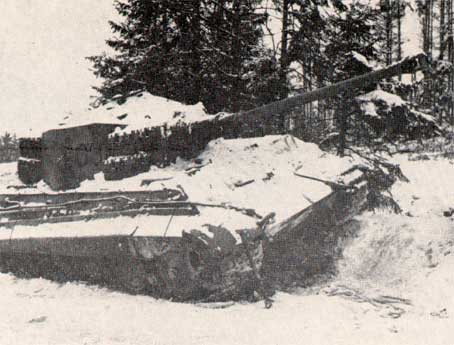 Eliminated German tank. Source: U.S. Army Center for military History.
Eliminated German tank. Source: U.S. Army Center for military History.The road to Bastogne open
On the morning of 18 December, in the north the Germans had forced an opening between the 112th and the 110th Regiment. The 112th joined up with the only remaining regiment of the 106th Infantry Division and concentrated on the defenses of St.Vith. Four German divisions had spread the 110th Infantry Regiment. Ever more American troops were completely destroyed or were forced to give up battle for various reasons. But in some places like in Marnach and Clervaux the American garrison had resisted the attacks for almost three days. In the evening of 18 December the regiment actually ceased to exist. On a total of 3.200 soldiers it counted 2.750 deaths, wounded and missed men. Herewith the Germans had created a wide gap in the American lines. The road to Bastogne was as good as accessible. Combat Command Reserve (CCR) of the 9th Armored Division was busy creating barricades around Antoniushaff and Feitsch, two crucial crossings on the road to Bastogne, which from there was only 9 kilometers away.
In the meantime in Mourmelon the parachutists of the 101st Airborne Division were kicked off their berths by their officers. This division stayed in France where they recovered from the campaign in the Netherlands. The losses had not yet been fully replenished and the newcomers required still some further training. The men were not fully equipped and only small supplies of ammunition were available. The division therefore was, to say the least, not optimally prepared for a new engagement with the Germans, but the 82nd and the 101st Airborne Divisions together with the British 3rd Corps were the only reserves available to General Eisenhower. The men of the two airborne divisions that were sent to Bastogne, suspected already that they had to participate in the battle again. "We all knew something was in the wind," said Corporal Butcher of the 81st Airborne Anti-Aircraft Artillery Battalion. "The Germans have broken through our lines someplace and it’s up to us to stop them."
Around the crossings near Antoniushaff and Feitsch laid commando units of the CCR . These hamlets did not comprise more than a few houses and farms and provided therefore only little protection but they were the last crossroads on the road to Bastogne. Task Force Rose commiserated Antoniushaff and Task Force Harper did the same with Feitsch. Both combat units consisted of a part of a tank battalion completed with infantry and engineers. In the afternoon Task Force Rose was attacked. First by three tanks, but later on by two battalions of tanks. The combat unit was crushed and only a few Americans succeeded in escaping captivity and reached Bastogne. At the beginning of the evening also Task Force Harper was attacked. First they were fired at by artillery and after that the German tanks opened fire. Within a few minutes the Germans succeeded in destroying a large part of the Harper group and to kill the commander himself. Just like in Antoniushaff the Americans had sacrificed themselves to a much superior enemy, only to create time for their comrades to reach Bastogne and to set up defenses. The 9th Armored Division during the first weeks of the battle in the Ardennes was on a so called "secret list". This meant that the enemy was not aware of its existence and this was deliberately kept that way. Therefore at that time nothing was revealed about its availability and the part it played in the race for Bastogne. The division also never ever received credits for its participation and contribution.
The commander of the 28th, Norman ‘Dutch’ Cota in the meantime was still in Wiltz. Here he had only thirty to forty men at his availability, the last line on the road to Bastogne. He composed a battalion from financial staff, cooks, drivers, map makers, medics, quartermasters and even the musicians of the division’s music band. Some of them did not even know how to reload a weapon, but Cota did not have any more professional soldiers at his disposal.
Definitielijst
- Infantry
- Foot soldiers of a given army.
- Regiment
- Part of a division. A division divided into a number of regiments. In the army traditionally the name of the major organised unit of one type of weapon.
Images
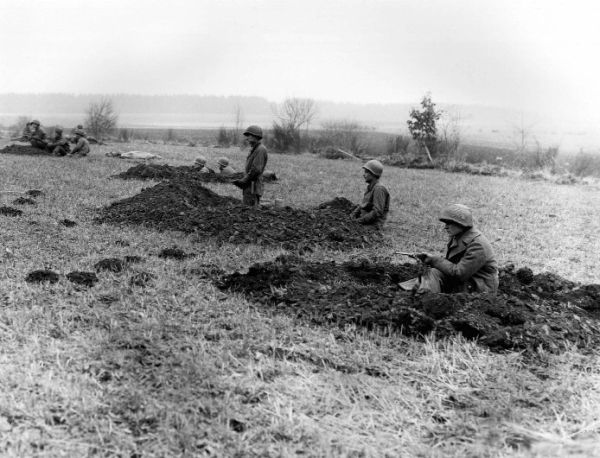 Tank crews creating a line of defens Source: U.S. Army Center for military History.
Tank crews creating a line of defens Source: U.S. Army Center for military History.Reinforcements and the establishment of the defenses
In the afternoon of 18 December Combat Command B of the 10th Armored Division had arrived in Bastogne. Colonel Roberts visited Middleton. The General explained to him that the 28th ID and the 9th Armored were defending themselves tooth and nail, but were in a bad shape. He commanded Roberts to split his force and to keep hold of the many roads leading towards Bastogne. Roberts asked for the authorization to enlist every man into his unit he met on the way and who was still able to fight. A few moments later another commander paid a visit to Middleton. This time it was Brigadier-General Anthony McAuliffe, in the absence of General Maxwell Taylor temporarily commander of the 101st Airborne Division. He had gone ahead before his division in order to explore the situation. The advance of his division had been seriously hindered by all kinds of vehicles that withdrew from the Bastogne area. Also Middleton and his staff left Bastogne after having briefed Roberts and McAuliffe. He wished McAuliffe good luck in the approaching battle. The Americans would have to hold out until the reinforcements would arrive.
Colonel Roberts composed three battle groups from his Combat Command B in order to halt the advancing Germans. These three teams established road blocks at the crossroads of the most important roads in the Bastogne surroundings. One team, Team Desobry, went to Noville, Team O’Hara went eastwards to Wardin and Team Cherry was in between in the direction of Longvilly. Each team carried the name of its commander and consisted approximately of one company of tanks, one company infantry, some sappers, medics and pathfinders. The paratroopers of the 101st Airborne Division arrived in the afternoon of the 18th December in the Bastogne area and McAuliffe sent the 501st Parachute Infantry Regiment to reinforce Team Cherry. A roadblock of Team Cherry had been walked over by German infantry, supported by tanks. In spite of heavy losses Team Cherry and the paras succeeded to prevent a breach through to Bastogne.
On the same 18th December Team Desobry had arrived at Noville, just before midnight. Desobry had defenses set up with barricades on the roads to Noville. Early in the morning of 19 December Team Desobry was attacked by units of the 2. Panzerdivision. Around 10:30 am a tank battle developed around Noville. Team Desobrey had received reinforcements from the 609th Tank Destroyer Battalion. The Germans lost seventeen tanks. Team Desobrey lost one tank destroyer and four smaller vehicles. Desobry was aware that his battle force in the end would be too small to stop the Germans. He wanted to withdraw from Noville but Roberts wanted to keep the Germans as far away from Bastogne as possible until the defenses there were in order. Desobry had to stand fast at all cost. The team was reinforced with the first battalion of the 506th Parachute Infantry Regiment. Paratrooper Donald Burgett (known from his autobiography in four parts) became involved in heavy fighting whereby he had to face infantry and tanks: "Grenades exploded all around us. The left sleeve of my jump jacket was torn from cuff to elbow. The hair on my left arm and the left side of my face were singed. My skin was blackened by burnt powder." In de morning of December 20 the Germans cut off the road to Bastogne. McAuliffe ordered to leave Noville and to fall back on Bastogne. On the way from Noville the Americans were attacked. This caused heavy losses. Towards the evening the survivors arrived from Noville in Bastogne.
McAuliffe had the availability of the 101st Airborne Division, Combat Command B of the 10th Armored Division and the 705th Tank destroyer battalion. Another Team was created: ‘SNAFU’ (short for
Definitielijst
- Destroyer
- Very light, fast and agile warship, intended to destroy large enemy ships by surprise attack and eliminating them by using torpedoes.
- infantry
- Foot soldiers of a given army.
- paratroopers
- Airborne Division. Military specialized in parachute landings.
- Regiment
- Part of a division. A division divided into a number of regiments. In the army traditionally the name of the major organised unit of one type of weapon.
Images
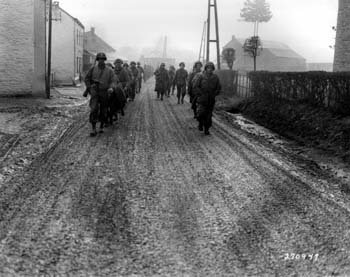 Soldiers of the 28th Infantry Division in Bastogne Source: U.S. Army Center for military History.
Soldiers of the 28th Infantry Division in Bastogne Source: U.S. Army Center for military History.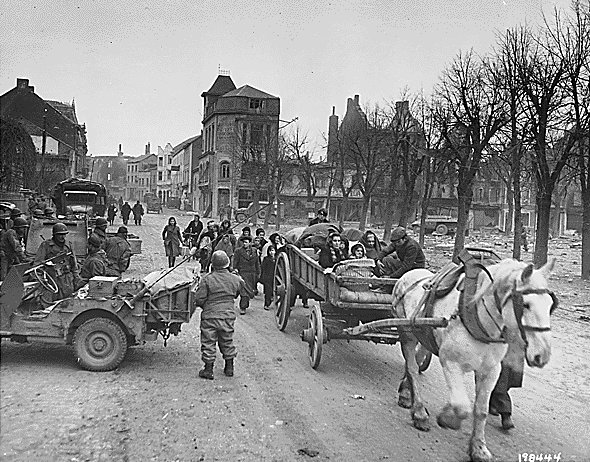 Civilians leave Bastogne Source: U.S. Army Center for military History.
Civilians leave Bastogne Source: U.S. Army Center for military History.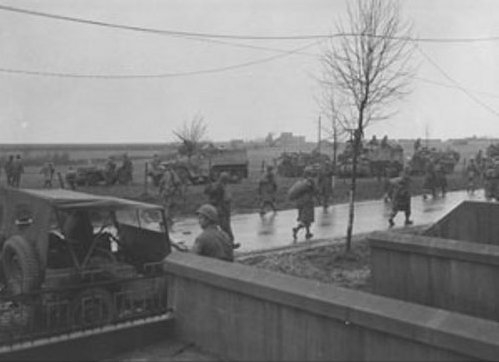 Troops of the 101st Airborne Division arrive at Bastogne. Source: U.S. Army Center for military History.
Troops of the 101st Airborne Division arrive at Bastogne. Source: U.S. Army Center for military History.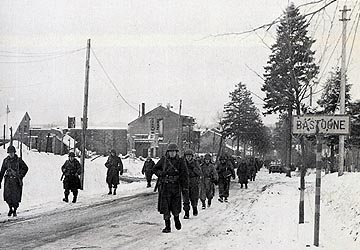 Soldiers of the 101st Airborne Division on their way to their positions Source: U.S. Army Center for military History.
Soldiers of the 101st Airborne Division on their way to their positions Source: U.S. Army Center for military History.Information
- Article by:
- Pieter Schlebaum
- Translated by:
- Fred Bolle
- Published on:
- 30-11-2014
- Last edit on:
- 30-09-2024
- Feedback?
- Send it!
